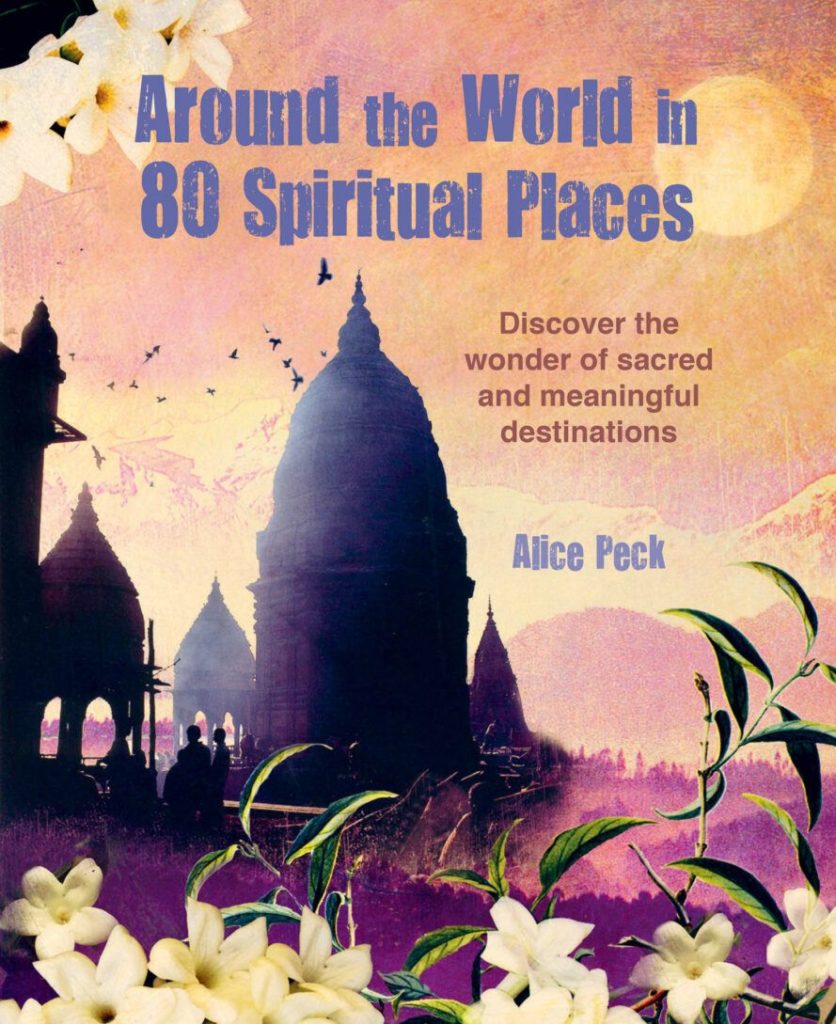
New travel book “Around the World in 80 Spiritual Places”
I frequently visit cemeteries, but was especially excited to be at Green-Wood Cemetery in Brooklyn last month. This historic cemetery is an enormous greenspace, fronted by gothic arches and full of birds, prairie dogs, flowering trees and interesting monuments to people ranging from obscure to celebrities. I was drawn to a pyramid-shaped tomb with a huge gold sculpture of animals leaning on the grassy hill below it.

When I got close, I saw that it commemorated Henry Bergh (1813 to 1888), founder of the American Society for the Prevention of Cruelty to Animals (ASPCA). On the door of his mausoleum, a round brass relief depicted an angel intervening as a carriage driver whipped his horse. I surprised myself by starting to cry pretty hard, overcome by feeling for this man on the forefront of animal protection. Seldom have I been so moved in a cemetery.
Related: This new book documents a permaculture hotspot in Berlin
And so when I thumbed through Alice Peck’s book “Around the World in 80 Spiritual Places” a week after visiting Green-Wood I was startled to see the cemetery is the last entry in her book. She said it was the most personally meaningful of all her 80 places. It was a weird moment of synchronicity.
I’m sure many readers will find themselves relating to one of these 80 places, or thinking of the spots of a most spiritual significance to them. Peck’s book will surely make people slow down and contemplate the intangibles that make certain places feel so powerful.

What is a spiritual place?
But what makes a place spiritual? Is it religion? Nature? Collected centuries of people’s beliefs? For Peck, all of these may apply. She acknowledges that places aren’t inherently spiritual. Instead, people imbue them with mysticism.
“Spiritual places are made when we feel a pure connection to something far greater than ourselves,” she wrote in the introduction.
Each entry begins with a few factual paragraphs about the place, accompanied by a lovely color photo. Since straight prose is not always the most direct way to the soul, Peck includes meditations, prayers and quotes throughout the book. The entry on the Ras al Hadd Turtle Reserve in Oman mentions that in Arab folklore, turtles symbolize patience, humility and persistence, and encourages readers to relate these turtle powers to their own lives. In the page on Chile’s Atacama Desert, Peck quotes famous Chilean Poet Pablo Neruda. These quotes and commentaries help the reader find connection with and caring for these far-flung places, whether they aspire to visit them or not.
One theme that Peck brings up repeatedly is liminal or thin places. These are special spots where people feel they are sort of in this world, and sort of in another. As Franciscan Priest Richard Rohr described the feeling, “Liminality is an inner state and sometimes an outer situation where people can begin to think and act in genuinely new ways. It is when we are betwixt and between, have left one room but not yet entered the next room.”
The big 80
Peck divides her chosen 80 places into five geographical chapters: Europe, Middle East and Africa, Asia and Australasia, Caribbean and Central and South America and North America. Many spiritual traditions are highlighted, from those as obvious as Vatican City’s Sistine Chapel to those with a lower international profile, such as the Shrine of Hazrat Shah Jalal in Bangladesh, the burial place of a 14th-century Sufi saint. Peck celebrates Indigenous spirituality in places like the Moose Mountain Medicine Wheel in Saskatchewan and South Dakota’s Black Hills, where Lakota peoples perform the sacred Sun Dance.
The spiritual often overlaps with places of great natural beauty, including forests, mountains and volcanoes. Kuumbi Cave in Tanzania is a good example of the way in which one place can have many important meanings. The cave is at once full of stalactites and other beautiful natural features, intriguing to archeologists and still used for weekly rituals by local people. The Zanzibar leopard was declared extinct 25 years ago. But in 2018, conservationists recorded one on a wildlife camera. The leopard is rumored to hide in the cave.
Strangely, a place in the book that captured my imagination was one of the least physically attractive. The Kamppi Chapel of Silence in Helsinki, Finland is a windowless room made of alder wood and set aside for quiet contemplation. As Peck explained, “Silence is a national trait.” The Finnish Tourist Board has declared silence a resource and declared, “In the future, people will be prepared to pay for the experience of silence.”

Your own 80 places
When I picked up this book I immediately found myself counting up how many of the places I’d visited — a temptation I’m sure many readers share. In my case, I tallied up eleven. But as Peck explains, her book isn’t intended to be a travel book. Instead, she calls it a dream book. The point is not to check these 80 places off your bucket list. Instead, it’s to marvel at the spiritual aspects of many places on Earth, whether a hallowed spot people have worshiped at for millennia, or somewhere with individual significance just for you.
“No matter where we go, Mount Kailash or the greengrocers, a cathedral or a graveyard, or how we get there, via pilgrim’s walk or city bus, we can be on a spiritual journey,” Peck wrote. “My wish is that this book gives you just this — a forgotten window to look through, a moment of awe and hope, a new path to voyage through the adventure that is your life.”
+ “Around the World in 80 Spiritual Places” by Alice Peck
